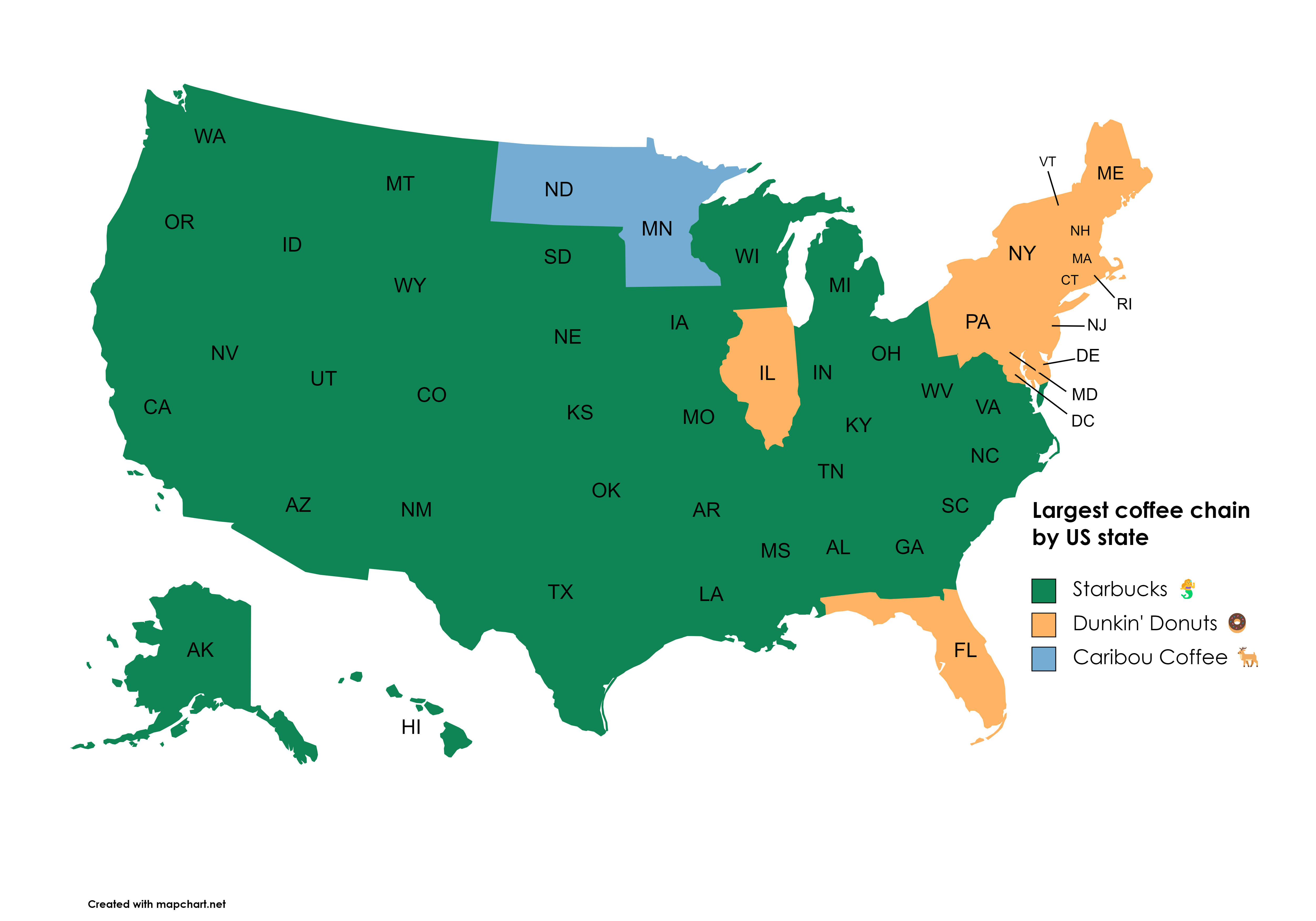Largest Coffee Chains in the USA Map


David Chen
Data Visualization Specialist
David Chen is an expert in transforming complex geographic datasets into compelling visual narratives. He combines his background in computer science ...
Geographic Analysis
What This Map Shows
This map illustrates the distribution and prevalence of the largest coffee chains across the United States. It highlights not only the sheer number of locations for each chain but also reveals the geographical concentration of these beloved caffeine providers. Looking at this map, one can immediately see the dominance of certain brands in various regions, as well as areas where smaller chains or independent coffee shops thrive.
Deep Dive into Coffee Culture in the USA
Coffee is more than just a beverage; it’s a cultural phenomenon in the United States. The coffee industry has grown exponentially over the past few decades, transforming from a simple morning ritual into a multi-billion-dollar market. The largest coffee chains—primarily Starbucks, Dunkin’, and Peet’s Coffee—have become household names, each with its unique identity and customer base.
Starbucks, established in Seattle in 1971, has expanded to more than 15,000 locations across the U.S. Its success is often attributed to its innovative marketing strategies, including the creation of a ‘third place’ between home and work where people can relax or work. Interestingly, Starbucks locations tend to cluster in urban areas and affluent neighborhoods, reflecting its positioning as a premium product.
On the other hand, Dunkin’, which originated in Massachusetts in 1950, focuses on coffee and baked goods. With over 9,000 locations nationwide, Dunkin’ has carved out a niche as a go-to for quick service and affordability. It’s particularly popular in the Northeast, where coffee drinkers prefer a no-frills experience.
Peet’s Coffee, while smaller than its competitors, has made its mark with a focus on artisanal coffee and quality brewing techniques. Founded in California in 1966, Peet’s has expanded primarily in the western states, where it appeals to consumers seeking a specialty coffee experience.
The diversity in offerings and branding strategies among these coffee giants illustrates a broader trend in consumer preferences. According to the National Coffee Association, nearly 64% of Americans drink coffee daily, with a growing interest in specialty coffee and single-origin brews. This shift is reflected in the rise of local coffee shops and roasters, which often emphasize unique flavors and sustainable sourcing practices.
Regional Analysis
When examining the map of the largest coffee chains, it's evident that location plays a significant role in coffee consumption patterns. For instance, the West Coast, particularly Starbucks' home turf in Seattle, shows a high density of Starbucks locations. This area also exhibits a strong preference for specialty coffee, which is evident in the presence of numerous independent coffee shops.
Conversely, the Northeast is a Dunkin’ stronghold, with dense clusters of stores in states like Massachusetts and New York. Interestingly, Dunkin’ has become synonymous with the morning commute, as many consumers grab their coffee on the go. In contrast, regions like the Midwest show a more balanced mix of both chains, indicating varied consumer preferences that may reflect local culture and lifestyle.
In the South, coffee consumption is on the rise, but it is still overshadowed by tea and other beverages. Here, chains like Starbucks are expanding their footprint, but they often face tough competition from local cafes that focus on Southern hospitality and unique blends. The regional differences in coffee chain dominance underscore the diverse coffee culture across the country, influenced by local preferences and lifestyles.
Significance and Impact
Understanding the landscape of coffee chains in the U.S. is crucial for several reasons. First, it highlights consumer behavior trends, indicating a shift towards premium and artisanal coffee experiences. This shift has significant implications for local economies and the coffee supply chain, as more consumers seek sustainably sourced beans and support local businesses.
Moreover, the coffee industry impacts employment, with thousands of jobs created in retail, agriculture, and logistics. The rise of coffee chains has also led to increased competition, pushing local cafes to innovate and offer unique experiences to attract customers.
As we look to the future, projections indicate that coffee consumption will continue to grow, driven by evolving consumer tastes and preferences. Trends such as cold brew and nitro coffee, along with the growing popularity of plant-based milk alternatives, are likely to shape the industry further. The map of largest coffee chains provides a snapshot of this dynamic landscape, reflecting both the challenges and opportunities within the coffee market.
In conclusion, coffee chains are not just about caffeine; they represent a complex interplay of culture, economy, and geography. As you sip your next cup, have you ever thought about the journey it took to reach you and the myriad of choices available? This map serves as a reminder of the vibrant coffee culture that continues to thrive across the United States.
Visualization Details
- Published
- August 28, 2025
- Views
- 90
Comments
Loading comments...